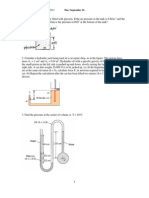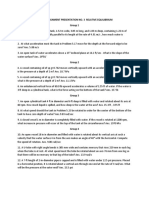0 ratings0% found this document useful (0 votes)
33 viewsFLUID Assignment 1
This document outlines 7 physics problems related to pressure and fluid measurements that are assigned to be completed and submitted on April 11, 2023. The problems involve calculating barometer readings at different elevations, pressure exerted by water in a tank, pressure at the bottom of a tank partially filled with glycerin, determining the specific gravity of an unknown liquid in a tank using pressure measurements, calculating absolute air pressure based on a Bourdon gage reading, using a U-tube manometer to measure tank pressure, and determining the new differential reading in a manometer setup if one pressure changes while the other remains constant.
Uploaded by
John 777Copyright
© © All Rights Reserved
Available Formats
Download as PDF, TXT or read online on Scribd
0 ratings0% found this document useful (0 votes)
33 viewsFLUID Assignment 1
This document outlines 7 physics problems related to pressure and fluid measurements that are assigned to be completed and submitted on April 11, 2023. The problems involve calculating barometer readings at different elevations, pressure exerted by water in a tank, pressure at the bottom of a tank partially filled with glycerin, determining the specific gravity of an unknown liquid in a tank using pressure measurements, calculating absolute air pressure based on a Bourdon gage reading, using a U-tube manometer to measure tank pressure, and determining the new differential reading in a manometer setup if one pressure changes while the other remains constant.
Uploaded by
John 777Copyright
© © All Rights Reserved
Available Formats
Download as PDF, TXT or read online on Scribd
You are on page 1/ 1
Assignment 1.
To be submitted on April 11, 2023
1. On a given day, a barometer at the base of the Rizal Monument reads 29.97 in. of mercury. What would
the barometer reading be when you carry it up to the observation deck 500 ft above the base of the
monument?
2. A closed, 5-m-tall tank is filled with water to a depth of 4 m. The top portion of the tank is filled with air
which, as indicated by a pressure gage at the top of the tank, is at a pressure of 20 kPa. Determine the
pressure that the water exerts on the bottom of the tank.
3. A closed tank is partially filled with glycerin. If the air pressure in the tank is 6 lb/in2 and the depth of
glycerin is 10 ft, what is the pressure in lb/ft2 at the bottom of the tank?
4. An unknown immiscible liquid seeps into the bottom of an open oil tank. Some measurements indicate
that the depth of the unknown liquid is 1.5 m and the depth of the oil (specific weight floating on top is 5.0
m. A pressure gage connected to the bottom of the tank reads 65 kPa. What is the specific gravity of the
unknown liquid?
5. Bourdon gages are commonly used to measure pressure. When such a gage is attached to the closed
water tank as shown below the gage reads 5 psi. What is the absolute air pressure in the tank? Assume
standard atmospheric pressure of 14.7 psi.
6. A water-filled U-tube manometer is used to measure the pressure inside a tank that contains air. The
water level in the U-tube on the side that connects to the tank is 5 ft above the base of the tank. The
water level in the other side of the U-tube (which is open to the atmosphere) is 2 ft above the base.
Determine the pressure within the tank.
7. In Figure below pipe A contains gasoline , pipe B contains oil , and the manometer fluid is mercury.
Determine the new differential reading if the pressure in pipe A is decreased 25 kPa, and the pressure in
pipe B remains constant. The initial differential reading is 0.30 m as shown.
You might also like
- CE-324-HYDRAULICS-Principles-of-Hydrostatics-CopyNo ratings yetCE-324-HYDRAULICS-Principles-of-Hydrostatics-Copy17 pages
- Mendoza Kian Cedrick Bsce 3c Excercise 3No ratings yetMendoza Kian Cedrick Bsce 3c Excercise 34 pages
- 3.6 Bernoulli's Principle: Chapter 3 Forces and PressureNo ratings yet3.6 Bernoulli's Principle: Chapter 3 Forces and Pressure25 pages
- Echometer - Acoustic Foam Depression TestsNo ratings yetEchometer - Acoustic Foam Depression Tests12 pages
- Lesson 2: Principles of Hydrostatics: Units: Lb/in or Psi (English) N/M or Pa. (S.I.)No ratings yetLesson 2: Principles of Hydrostatics: Units: Lb/in or Psi (English) N/M or Pa. (S.I.)5 pages
- By James N. Mccoy, P: Resident, Echometer Co., Wichita Falls, TexNo ratings yetBy James N. Mccoy, P: Resident, Echometer Co., Wichita Falls, Tex4 pages
- Worksheet 2 PRINCIPLES OF HYDRSTATIC PRESSURE QuestionsNo ratings yetWorksheet 2 PRINCIPLES OF HYDRSTATIC PRESSURE Questions4 pages
- Group Assignment Presentation No. 3 Relative EquilibriumNo ratings yetGroup Assignment Presentation No. 3 Relative Equilibrium5 pages
- Pressure Pressure in A Liquid Atmospheric Pressure & Barometers Gas Pressure & ManometersNo ratings yetPressure Pressure in A Liquid Atmospheric Pressure & Barometers Gas Pressure & Manometers12 pages
- Day 24 - Fluid Mechanics L Lecture ProblemsNo ratings yetDay 24 - Fluid Mechanics L Lecture Problems3 pages
- Boyle's Law - Experiment 2: 0 Comments Lesson PlansNo ratings yetBoyle's Law - Experiment 2: 0 Comments Lesson Plans8 pages
- ANTIQUES A TO Z - A POCKET HANDBOOK FOR COLLECTORS AND DEALERSFrom EverandANTIQUES A TO Z - A POCKET HANDBOOK FOR COLLECTORS AND DEALERSNo ratings yet































































